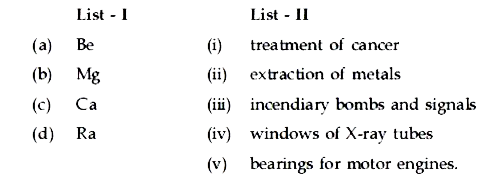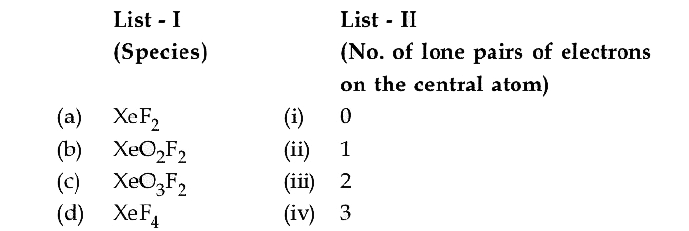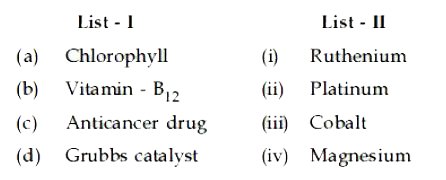Given below are two statements :
Statement I: Emulsions of oil in water are unstable and sometimes they separate into two layers on standing.
Statement II: For stabilisation of an emulsion, excess of electrolyte is added.
In the light of the above statements, choose the most appropriate answer from the options given below:
Both Statement I and Statement II are correct.
Both Statement I and Statement II are incorrect.
Statement I is correct but Statement II is incorrect.
Statement I is incorrect but Statement II is correct.
The correct Answer is:C
To solve the question, we need to analyze both statements provided:
Step 1: Analyze Statement I
- Statement I claims that emulsions of oil in water are unstable and can separate into two layers upon standing.
- Emulsions are mixtures of two immiscible liquids, and in the case of oil in water, they can indeed be unstable. Over time, the oil can separate from the water, leading to the formation of two distinct layers.
- Therefore, Statement I is True.
Step 2: Analyze Statement II
- Statement II states that for the stabilization of an emulsion, excess electrolyte is added.
- In reality, adding excess electrolyte can lead to the destabilization of an emulsion. This is because electrolytes can cause the charged particles in the emulsion to aggregate, leading to coalescence and separation of the phases.
- Therefore, Statement II is False.
Step 3: Conclusion
- Since Statement I is true and Statement II is false, we conclude that the correct answer is that Statement I is true and Statement II is false.
Final Answer:
- Statement I is True, Statement II is False.
---
- Statement I claims that emulsions of oil in water are unstable and can separate into two layers upon standing.
- Emulsions are mixtures of two immiscible liquids, and in the case of oil in water, they can indeed be unstable. Over time, the oil can separate from the water, leading to the formation of two distinct layers.
- Therefore, Statement I is True.
- Statement II states that for the stabilization of an emulsion, excess electrolyte is added.
- In reality, adding excess electrolyte can lead to the destabilization of an emulsion. This is because electrolytes can cause the charged particles in the emulsion to aggregate, leading to coalescence and separation of the phases.
- Therefore, Statement II is False.
- Since Statement I is true and Statement II is false, we conclude that the correct answer is that Statement I is true and Statement II is false.
- Statement I is True, Statement II is False.
Topper's Solved these Questions
- JEE MAINS 2022BOOK - JEE MAINS PREVIOUS YEARCHAPTER - JEE MAINS 2022EXERCISE - Chemistry-Section B
60 Videos
- JEE MAINS 2022BOOK - JEE MAINS PREVIOUS YEARCHAPTER - JEE MAINS 2022EXERCISE - PHYSICS (SECTION B)
1 Videos
- JEE MAINS 2021BOOK - JEE MAINS PREVIOUS YEARCHAPTER - JEE MAINS 2021EXERCISE - Chemistry (Section B )
10 Videos
- JEE MAINS 2023 JAN ACTUAL PAPERBOOK - JEE MAINS PREVIOUS YEARCHAPTER - JEE MAINS 2023 JAN ACTUAL PAPEREXERCISE - Question
360 Videos
Similar Questions
Knowledge Check
Match List - I with List- II

Choose the most appropriate answer from the options given below -A(a)→(ii),(b)→(iii),(c)→(iv),(d)→(i)B(a)→(i),(b)→(iv),(c)→(iii),(d)→(ii)C(a)→(i),(b)→(iii),(c)→(iv),(d)→(ii)D(a)→(iv),(b)→(i),(c)→(ii),(d)→(iii)Match List - I with List- II

Choose the most appropriate answer from the options given below -A(a)→(i),(b)→(iii),(c)→(iv),(d)→(ii)B(a)→(ii),(b)→(i),(c)→(iv),(d)→(iii)C(a)→(ii),(b)→(iv),(c)→(i),(d)→(iii)D(a)→(iii),(b)→(i),(c)→(ii),(d)→(iv)
Match List - I with List -II

Choose the most appropriate answer from the options given below :
View SolutionMatch List -I with List-II :

Choose the most appropriate answer from the option given below:
View SolutionMatch List-I with List-II :

Choose the most appropriate answer from the options given below :
View SolutionMatch List-I with List-II :

Choose the most appropriate answer from the options given below :
View SolutionMatch List -I with List -II :

Choose the most appropriate answer from the options given below :
View SolutionMatch List - I with List - II

Choose the most appropriate answer from the options given below :
View Solution


